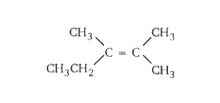The given diagram is highly diagrammatic representation of mammalian heart. In this diagram
(##EVR_ANM_ICSE_BIO_X_C07_E01_022_Q01.png" width="80%">
From where do the parts numbered 1- 6 receive blood ?
To answer the question regarding where the parts numbered 1-6 of the mammalian heart receive blood from, we can follow these steps:
1. Identify Part 1: Superior Vena Cava
- The superior vena cava receives deoxygenated blood from the upper parts of the body, including the head, neck, and arms.
2. Identify Part 2: Pulmonary Vein
- The pulmonary vein receives oxygenated blood from the lungs. After the blood is oxygenated in the lungs, it returns to the heart through the pulmonary veins.
3. Identify Part 3: Bicuspid Valve (Mitral Valve)
- The bicuspid valve itself does not receive blood; rather, it regulates the flow of oxygenated blood from the left atrium to the left ventricle. The left atrium receives oxygenated blood from the pulmonary veins.
4. Identify Part 4: Aortic Semilunar Valve
- Similar to the bicuspid valve, the aortic semilunar valve does not receive blood directly. It allows oxygenated blood to flow from the left ventricle into the aorta, which supplies blood to the body.
5. Identify Part 5: Left Ventricle
- The left ventricle receives oxygenated blood from the left atrium through the bicuspid valve.
6. Identify Part 6: Right Auricle (Right Atrium)
- The right auricle receives deoxygenated blood from the body through the superior vena cava and inferior vena cava.
Summary of Blood Sources for Parts 1-6:
- Part 1 (Superior Vena Cava): Deoxygenated blood from the upper body.
- Part 2 (Pulmonary Vein): Oxygenated blood from the lungs.
- Part 3 (Bicuspid Valve): Regulates flow from left atrium (which receives blood from pulmonary veins).
- Part 4 (Aortic Semilunar Valve): Allows flow from left ventricle to aorta (which supplies blood to the body).
- Part 5 (Left Ventricle): Oxygenated blood from left atrium (via bicuspid valve).
- Part 6 (Right Auricle): Deoxygenated blood from the body (via superior and inferior vena cava).
- The superior vena cava receives deoxygenated blood from the upper parts of the body, including the head, neck, and arms.
- The pulmonary vein receives oxygenated blood from the lungs. After the blood is oxygenated in the lungs, it returns to the heart through the pulmonary veins.
- The bicuspid valve itself does not receive blood; rather, it regulates the flow of oxygenated blood from the left atrium to the left ventricle. The left atrium receives oxygenated blood from the pulmonary veins.
- Similar to the bicuspid valve, the aortic semilunar valve does not receive blood directly. It allows oxygenated blood to flow from the left ventricle into the aorta, which supplies blood to the body.
- The left ventricle receives oxygenated blood from the left atrium through the bicuspid valve.
- The right auricle receives deoxygenated blood from the body through the superior vena cava and inferior vena cava.
- Part 1 (Superior Vena Cava): Deoxygenated blood from the upper body.
- Part 2 (Pulmonary Vein): Oxygenated blood from the lungs.
- Part 3 (Bicuspid Valve): Regulates flow from left atrium (which receives blood from pulmonary veins).
- Part 4 (Aortic Semilunar Valve): Allows flow from left ventricle to aorta (which supplies blood to the body).
- Part 5 (Left Ventricle): Oxygenated blood from left atrium (via bicuspid valve).
- Part 6 (Right Auricle): Deoxygenated blood from the body (via superior and inferior vena cava).
Topper's Solved these Questions
Similar Questions
The given diagram is highly diagrammatic representation of mammalian heart. In this diagram
(##EVR_ANM_ICSE_BIO_X_C07_E01_020_Q01.png" width="80%">
What do the arrows indicate ?
View SolutionThe given diagram is highly diagrammatic representation of mammalian heart. In this diagram
(##EVR_ANM_ICSE_BIO_X_C07_E01_021_Q01.png" width="80%">
Name the valves that guard openings in the heart.
View Solution
Knowledge Check
The given image represents:
(##OSW_GRU_MCQ_ISC_XII_SM1_BIO_C05_E01_070_Q01.png" width="80%">Achromosomes assorting independently.Bsegregation of incompletely linked genes.Ccrossing over between factors carried on the chromosomes.DBoth (a) and (c)Match the items of column A to those given in column B.
(##OSW_GRU_MCQ_ISC_XII_SM1_CHE_C01_E01_039_Q01.png" width="80%">A1-(q), 2-(p), 3-(t), 4-(r), 5-(s), 6-(v), 7-(u)B1-(p), 2-(q), 3-(s), 4-(r), 5-(t), 6-(u), 7-(v)C1-(v), 2-(s), 3-(u), 4-(p), 5-(r), 6-(q), 7-(t)D1-(r), 2-(u), 3-(t), 4-(q), 5-(v), 6-(s), 7-(p)What,is the major product ofthe following reaction?
(##BLJ_MSC_OBJ_CHE_JEE_C05B_E01_057_Q01.png" width="80%">A B
B C
C D
D
The given diagram is highly diagrammatic representation of mammalian heart. In this diagram
Name the parts marked 1-12.

View SolutionMatch the properties and uses of alloys in List 1 with the appropriate answer from List 2.
(##EVRBLKICSECHEX_C07E06054_Q01.png width=80%>
View SolutionIn the given figure. AB is the diameter of the circle with centre O.
(##SELRKBICSEMATX_C17E04012_Q01.png width=80%><br>If angle ADC = 32 ^(@) , find angle BOC.
View SolutionCalculate the angles x,y and z if
x3=y4=z5
(##SEL_RKB_ICSE_MAT_X_C17_E02_042_Q01.png" width="80%">
View SolutionMatch the column I with column II and select the correct option.
(##OSW_GRU_MCQ_ISC_XII_SM1_BIO_C05_E01_065_Q01.png" width="80%">
View Solution
